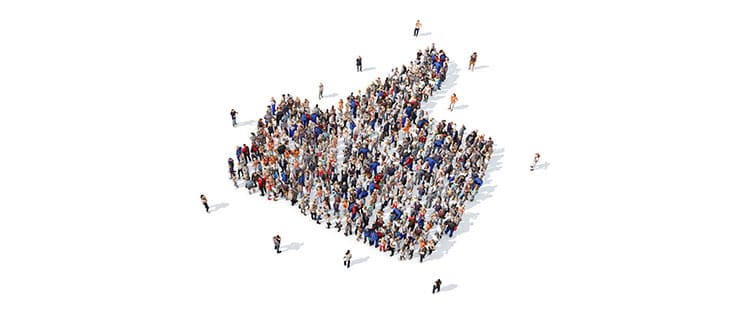If you’re considering leveraging Facebook as an advertising platform for your business, it’s important to learn about the different types of ads and the factors that influence the costs.
Knowing these differences can help you optimize your marketing efficiency while minimizing your Facebook advertising costs and maximizing your return on investment (ROI).
So if you’re wondering how much does it cost to advertise on Facebook, we have some insight on the matter.
Facebook Advertising Cost Estimates
Facebook measures costs in different ways, depending on what type of advertising you choose. Some of the most popular measures for quoting prices are cost per click and cost per thousand impressions, also called cost per mille.
As of 2020, Facebook ads averaged $1.72 per click and $7.19 per thousand views, according to WordStream and WebFX, respectively. The average small business spends a Facebook advertising cost per month of about $200 to $800. However, you can budget as much or as little as you want for Facebook advertising.
As a Rule of Thumb
In the past, the U.S. Small Business Administration recommended that small companies earning less than $5 million annually have a net profit margin in the range of 10% to 12% should allocate an amount equivalent to 7% to 8% of gross revenue for advertising.
Bear in mind that this figure includes both Facebook advertising as well as other types of advertising, so you’ll need to consider what portion of your marketing budget should go toward Facebook.
Adjust this guideline based on your needs and your cash flow.
You may wish to do a small-scale test of the results you get from Facebook advertising against different marketing methods to see what gets the best results. You also can test different campaigns to see which ones work best. Then, you can scale up when you know a particular method or ad is turning a good profit.
Facebook Ads Pricing by Industry
The cost of a Facebook advertising campaign varies by industry because costs are determined by bidding popularity and other factors. According to WordStream, the apparel industry enjoyed the lowest rate at 45 cents per click. The finance and insurance industry pays the most expensive rate at $3.77 per click. The average cost across all industries at that time was $1.72.
Types of Facebook Ad Costs
Facebook offers 5 different types of advertising cost structures:
- Cost per click (CPC): Advertiser charged based on number of clicks an ad receives
- Cost per mille (CPM): Charged per thousand impressions
- Cost per action (CPA): Based on actions generated by an ad, such as registrations for an email list
- Cost per like (CPL): Based on page likes generated by an ad
- Cost per view (CPV): Used for video ads
Each of these options has its own best way to use it.
Facebook Advertising Cost Per Click
When you choose the CPC method, you get charged whenever a Facebook user clicks on your ad. Advertisers typically use this method to drive traffic to a website or blog. Typical calls to action used with this type of ad include:
- Buy now
- Sign up
- Learn more
Facebook CPC costs an average of $1.72 per click.
Facebook Advertising Cost Per Mille
This is a Facebook advertising method based on cost per impression, except with Facebook advertising CPM, the cost only is incurred every thousand impressions. In other words, you get charged for every thousand people who see your ad, even if they don’t click on it.
This type of advertising campaign works well for building brand awareness, but it does not guarantee clicks to your site, so it is priced relatively more cheaply than CPC.
Facebook Advertising Cost Per Action
Cost per action is similar in concept to cost per click advertising, except charges are based on other designated actions besides clicking. For instance, you might elect to pay for any of the following actions generated by an ad:
- Per email subscriber list registration
- Per app download
- Per sale
Because these types of actions represent high value for the advertiser per action, CPA advertising is priced more expensively than other types of Facebook advertising. The current average cost for CPA advertising is $18.68 per action. This varies per industry, rising as high as $55.21 for technology advertisers. To make CPA cost-effective, the value generated per action should outweigh the CPA.
Facebook Advertising Cost Per Like
CPL also is similar in concept to cost-per-click advertising, except here you pay for each like that your ad campaign generates for your Facebook page. This advertising method caters to brands seeking to build a Facebook following.
Because it translates into likes rather than translating directly into revenue, it is priced more cheaply than other methods, at an average of $1.07 per like.
Facebook Advertising Cost Per View
Designed for video advertising, this method is similar both in name and concept to pay-per-view video — except in contrast to pay-per-view, it is the advertiser rather than the consumer who pays when someone views their video.
Advertisers get charged each time a video plays for at least 3 seconds, making this method best for videos that can quickly grab viewer attention and communicate a core message.
Videos that require longer viewing time may be better served by other advertising methods. The average pricing ranges from 1 cent to 15 cents per video depending on the industry, according to third-party reports.
Variables Influencing Facebook Ads Costs
Facebook uses an algorithm to set the price of ad campaigns. A number of variables can impact the cost of your ad. These include:
- Bid amount
- Competition
- Target audience
- Ad objective
- Ad type
- Ad quality
- Ad relevance score
- Ad placement
- Ad scheduling
Bid Amount
Facebook uses a bidding system to set the price of ads. When you create a bid for a Facebook ad, you choose the target audience you’re trying to reach, the type of ad you want to place, and the amount you’re willing to pay for your ad campaign. This helps determine the reach and cost of your ad.
Competition
Because Facebook uses an auction bidding system, you’re competing for the same audience and ad space with other brands. This means that the more competition there is for the same audience and ad space, the more you’ll have to pay.
Target Audience
In contrast to platforms such as Google that allow advertisers to target keywords, Facebook allows you to target audiences based on demographic features and other characteristics. Facebook offers hundreds of options you can choose to define your target audience. The options you select impact how much competition you will have to bid against, affecting the price of your ad.
Ad Objective
Different types of Facebook ad campaigns have different objectives that directly relate to how much revenue the advertiser can hope to earn from the campaign.
For instance, a campaign that only raises audience awareness of your brand without getting them to click on a link generates less direct revenue than a campaign geared towards getting them to make a purchase. The more revenue you expect to get from your ad campaign, the more Facebook will charge you.
Ad Type
Different ad objectives correspond to the different types of ads Facebook offers, affecting the price. For instance, a CPM ad campaign is priced based on how many people see your ad even if they don’t click on a link, so it’s less expensive. A CPA campaign can get audiences to take revenue-generating actions such as clicking on sales page links, so it’s more expensive.
Ad Quality
Ad quality is another factor that can influence the cost of your ad, as well as its cost-efficiency. Blurry images and poor copy generate lower results than eye-catching graphics and compelling headlines.
While a cheap ad may seem less expensive, investing in quality graphics and copywriting may yield higher profits in the long run. Additionally, Facebook lets you choose from different types of graphics options, including slideshows with animation and audio, rotating carousels and videos.
Ad Relevance Score
The ad relevance score is a metric from 1-10 that Facebook uses to assess the relevance of your ad to your target audience. The level of interactions that users have with your ad impacts your score.
If a large portion of users interact positively with your ad, your score will most likely increase. On the other hand, if a majority of users click out of your ad or send negative feedback to Facebook that the ad’s irrelevant to them, your score will be lowered.
Ad Placement
Facebook gives you different options for where to place your ad with varying pricing structures. These options include displays:
- In the user’s Facebook newsfeed
- In the Facebook video feed
- In the right column of the user’s Facebook display
- On the Facebook Marketplace home page
- In the user’s Messenger inbox
- In the user’s feed for their account on Instagram, which is owned by Facebook
- In Instagram Explore, where the user will see it when they click on a photo or video
- In stories on Facebook, Messenger, or Instagram
- As in-stream content played before, during or after videos
- As Messenger-sponsored messages that appear when a person is having a conversation with you on Messenger
- In Facebook Instant Articles that appear on the Facebook mobile app
- In external apps and sites within Facebook’s Audience Network, an off-Facebook network affiliated with Facebook
Ad Scheduling
A final factor that affects your advertising costs is how you schedule your ads. If you have a lifetime budget with Facebook, you can optimize your ad scheduling so that your ad only runs on certain days and at certain times when your target audience is most likely to see it.
Facebook’s Page Insights tool can help you determine when your target audience is most active on the platform.

Estimate Your Ad ROI
To make your advertising cost-effective, it’s important to estimate your ROI before running an ad campaign. To do this:
- Determine the monthly cost of your projected campaign
- Estimate the monthly revenue generated by your campaign by calculating:
- The number of clicks, views or other actions your campaign will generate
- What percentage of these will convert into paying customers
- The average lifetime value of each customer you acquire
- Compare your costs with your estimated revenue to see if your campaign will be profitable
Initially, these calculations will just be educated guesses. You will have a more accurate sense of what results your campaign will yield once you run it. This is why it’s a good idea to run your campaign on a small scale to see how your ad works before investing in large-scale advertising. Once you get an ad that works, keep running it and tweaking it to improve it.
Build Facebook Advertising into Your Budget
Facebook advertising can be one of the fastest and most cost-effective tools to quickly expand your customer base and generate sales.
Investing part of your marketing budget on Facebook should be a priority for any growing business. If you need additional cash flow to cover your Facebook advertising investment, consider applying for a small business loan or line of credit to jumpstart your company’s revenue.












